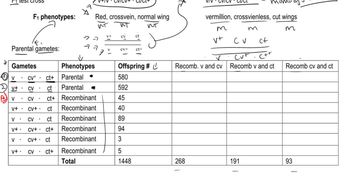In a cross between a black and a white guinea pig, all members of the F₁ generation are black. The F₂ generation is made up of approximately 3/4 black and 1/4 white guinea pigs. Diagram this cross, showing the genotypes and phenotypes.
Table of contents
- 1. Introduction to Genetics51m
- 2. Mendel's Laws of Inheritance3h 37m
- 3. Extensions to Mendelian Inheritance2h 41m
- 4. Genetic Mapping and Linkage2h 28m
- 5. Genetics of Bacteria and Viruses1h 21m
- 6. Chromosomal Variation1h 48m
- 7. DNA and Chromosome Structure56m
- 8. DNA Replication1h 10m
- 9. Mitosis and Meiosis1h 34m
- 10. Transcription1h 0m
- 11. Translation58m
- 12. Gene Regulation in Prokaryotes1h 19m
- 13. Gene Regulation in Eukaryotes44m
- 14. Genetic Control of Development44m
- 15. Genomes and Genomics1h 50m
- 16. Transposable Elements47m
- 17. Mutation, Repair, and Recombination1h 6m
- 18. Molecular Genetic Tools19m
- 19. Cancer Genetics29m
- 20. Quantitative Genetics1h 26m
- 21. Population Genetics50m
- 22. Evolutionary Genetics29m
2. Mendel's Laws of Inheritance
Monohybrid Cross
Problem 10a
Textbook Question
The dorsal pigment pattern of frogs can be either 'leopard' (white pigment between dark spots) or 'mottled' (pigment between spots appears mottled). The trait is controlled by an autosomal gene. Males and females are selected from pure-breeding populations, and a pair of reciprocal crosses is performed. The cross results are shown below.
Cross 1: P₁: Male leopard x male mottled
F₁: All mottled
F₂: 70 mottled, 22 leopard
Cross 2: P₁: Male mottled x female leopard
F₁: All mottled
F₂: 50 mottled, 18 leopard
Which of the phenotypes is dominant? Explain your answer.
 Verified step by step guidance
Verified step by step guidance1
Step 1: Understand the problem. The dorsal pigment pattern in frogs is controlled by an autosomal gene, and the phenotypes are 'leopard' and 'mottled'. The goal is to determine which phenotype is dominant based on the results of reciprocal crosses.
Step 2: Analyze the F₁ generation results. In both crosses, the F₁ generation consists entirely of mottled frogs, regardless of the parental phenotypes. This suggests that the mottled phenotype is dominant, as it appears in all offspring when crossed with leopard frogs.
Step 3: Examine the F₂ generation results. In Cross 1, the F₂ generation shows a ratio of 70 mottled to 22 leopard frogs. In Cross 2, the F₂ generation shows a ratio of 50 mottled to 18 leopard frogs. These ratios are consistent with a Mendelian inheritance pattern for a single autosomal gene with dominant and recessive alleles.
Step 4: Apply Mendelian genetics principles. If mottled is dominant and leopard is recessive, the F₁ generation (heterozygous) would produce a 3:1 phenotypic ratio in the F₂ generation (3 mottled:1 leopard). The observed ratios in both crosses approximate this expected ratio, further supporting the conclusion that mottled is dominant.
Step 5: Conclude based on evidence. The dominance of the mottled phenotype is supported by its appearance in all F₁ offspring and the approximate 3:1 ratio in the F₂ generation. This aligns with the principles of autosomal inheritance for a dominant-recessive trait.
 Verified video answer for a similar problem:
Verified video answer for a similar problem:This video solution was recommended by our tutors as helpful for the problem above
Video duration:
3mPlay a video:
Was this helpful?
Key Concepts
Here are the essential concepts you must grasp in order to answer the question correctly.
Dominance in Genetics
Dominance refers to the relationship between alleles of a gene, where one allele masks the expression of another in the phenotype. In this case, if all F₁ offspring from both crosses exhibit the mottled phenotype, it suggests that the allele for mottled is dominant over the allele for leopard.
Recommended video:
Guided course

Variations on Dominance
Phenotypic Ratios
Phenotypic ratios are the relative frequencies of different phenotypes in the offspring resulting from a genetic cross. The F₂ generation shows a consistent ratio of mottled to leopard phenotypes, which can be analyzed to determine the dominance of traits. The observed ratios help confirm the dominance of the mottled phenotype.
Recommended video:
Guided course

Mutations and Phenotypes
Reciprocal Crosses
Reciprocal crosses involve switching the sexes of the parents in a genetic cross to determine if the inheritance pattern is influenced by sex. In this scenario, both crosses yield the same F₁ and F₂ results, indicating that the dominance of the mottled phenotype is not sex-linked, reinforcing the conclusion about the trait's inheritance.
Recommended video:
Guided course

Trihybrid Cross
Related Videos
Related Practice
Textbook Question
2909
views


